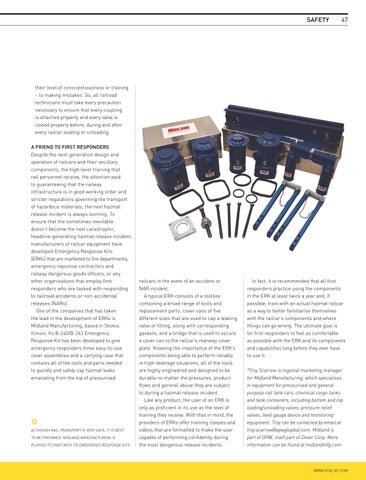SAFETY 47
their level of conscientiousness or training – to making mistakes. So, all railroad technicians must take every precaution necessary to ensure that every coupling is attached properly and every valve is closed properly before, during and after every railcar loading or unloading. A FRIEND TO FIRST RESPONDERS Despite the next-generation design and operation of railcars and their ancillary components, the high-level training that rail personnel receive, the attention paid to guaranteeing that the railway infrastructure is in good working order and stricter regulations governing the transport of hazardous materials, the next hazmat release incident is always looming. To ensure that the sometimes inevitable doesn’t become the next catastrophic, headline-generating hazmat release incident, manufacturers of railcar equipment have developed Emergency Response Kits (ERKs) that are marketed to fire departments, emergency repsonse contractors and railway dangerous goods officers, or any other organisations that employ first responders who are tasked with responding to railroad accidents or non-accidental releases (NARs). One of the companies that has taken the lead in the development of ERKs is Midland Manufacturing, based in Skokie, Illinois. Its B-240/B-243 Emergency Response Kit has been developed to give emergency responders three easy-to-use cover assemblies and a carrying case that contains all of the tools and parts needed to quickly and safely cap hazmat leaks emanating from the top of pressurised
ALTHOUGH RAIL TRANSPORT IS VERY SAFE, IT IS BEST TO BE PREPARED. MIDLAND MANUFACTURING IS PLAYING ITS PART WITH ITS EMERGENCY RESPONSE KITS
railcars in the event of an accident or NAR incident. A typical ERK consists of a toolbox containing a broad range of tools and replacement parts; cover cans of five different sizes that are used to cap a leaking valve or fitting, along with corresponding gaskets; and a bridge that is used to secure a cover can to the railcar’s manway cover plate. Knowing the importance of the ERK’s components being able to perform reliably in high-leverage situations, all of the tools are highly engineered and designed to be durable no matter the pressures, product flows and general abuse they are subject to during a hazmat release incident.
In fact, it is recommended that all first responders practice using the components in the ERK at least twice a year and, if possible, train with an actual hazmat railcar as a way to better familiarise themselves with the railcar’s components and where things can go wrong. The ultimate goal is for first responders to feel as comfortable as possible with the ERK and its components and capabilities long before they ever have to use it.
Like any product, the user of an ERK is only as proficient in its use as the level of training they receive. With that in mind, the providers of ERKs offer training classes and videos that are formatted to make the user capable of performing confidently during the most dangerous release incidents.
and tank containers, including bottom and top loading/unloading valves, pressure relief valves, level gauge device and monitoring equipment. Troy can be contacted by email at troy.scarrow@opwglopbal.com. Midland is part of OPW, itself part of Dover Corp. More information can be found at midlandmfg.com.
*Troy Scarrow is regional marketing manager for Midland Manufacturing, which specialises in equipment for pressurised and general purpose rail tank cars, chemical cargo tanks
WWW.HCBLIVE.COM
































